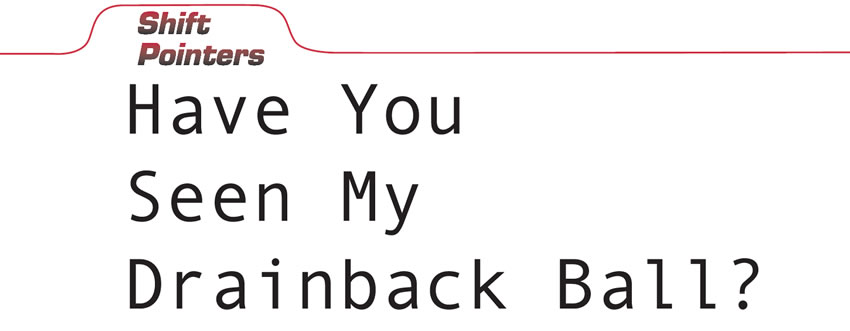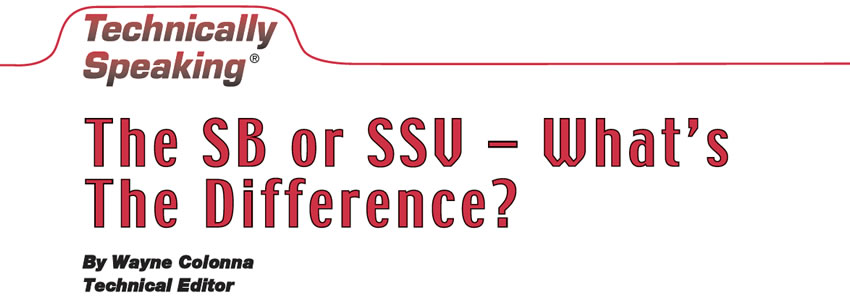Have You Seen My Drainback Ball?
When you unscrew the cooler-line fitting you notice that oil comes pouring freely. You now remove the cooler-line fitting, and lo and behold, there’s no #$^&*! checkball in the fitting.

The SB or SSV – What’s The Difference?
Often, DTCs related to the solenoid switch valve (SSV) in any 41TE or 42LE transmission are misinterpreted as a problematic solenoid body (SB). This may be attributed to the use of the word “solenoid” in the code definition. Code 37 is the solenoid switch valve stuck in the TCC position, and 47 is the solenoid switch valve stuck in the L/R position. Either of these will place the transmission in “limp mode.” The solenoid switch valve is not in the solenoid body but in the valve body (see Figure 1).

It’s a Game of Tag, and You’re It!
In many instances, during the repair process it is necessary for us to disconnect the battery or the computer. Sometimes this is all it takes to create a problem in the vehicle that was not there before.
Let’s take a look at some of these “disconnect”-related problems and how to correct them should this happen to you.

Code 47/633 in E4OD/4R100
Many technicians are familiar with the problem of early shift scheduling on the 4L80-E transmission. This prob¬lem is caused by a 4×4 low range signal being sent to the computer at an inappropriate time. Vehicles equipped with the E4OD/4R100 transmission may also have this type of problem. A code 47/633 is usually your first clue in identifying this condition. Since Ford uses the same wiring harness in both 4-wheel drive and 2-wheel drive vehicles, you may find code 47/633 in both types of vehicles.

A Case of Hide and Seek
One of the many automotive animals that technicians have to wrestle with is finding the definitions for the ever-increasing number of diagnostic codes. And then, of course, their definitions are being represented by a seemingly endless list of acronyms associated with that code. TCC, VSS and TPS are just a few recognizable acronyms in our industry today.

Part II – More 4L30 E Problems (Lots More)
Problems and Fixes for the 4L30 E transmission.

Replaced the What?
Sometimes a problem with a vehicle requires quite a bit of diagnostic head scratching, at the end of which you finally find what is causing the problem.

A Transfer-Case Identity Crisis
So in your ever-expanding list of causes for stacked upshifts in computer-controlled transmissions, even if it is a two-wheel-drive vehicle, investigate the possibility of a four-wheel-drive-low command being the culprit otherwise known as a transfer-case identity crisis.

Honda & Acura – the New Generation
This has now become a very frequent question on the tech line: “Hey, what are all these solenoids, and what in the world do they do?” The questions started in the 1997 model year, when the Honda Prelude came out with the M6HA transaxle. This was one of the first vehicles to receive this new-generation 4-speed. This article, I hope, will clear up some of the questions on shift strategy, clutch-pack applications and solenoid application. After all, how can you fix something if you don’t know how it works?

4L30-Es May Drive You Crazy – Part I
If any part of your sanity were ever in question, the 4L30 E transmission might be just the thing to put you over the edge. The most-common complaints concerning the 4L30 E usually have something to do with reverse. No reverse, little or no reverse, neutraling in reverse and partial TCC-lockup apply in reverse are only a few of the many problems.

EEC-IV and EEC-V Systems – Odd Behavior
EEC-IV and EEC-V systems sometimes may exhibit odd behavior such as erratic shifting, OD or engine light blinking, nonsense or unrelated codes, with no apparent cause.

Isuzu NPR/GMC Tiltmaster
The Isuzu NPR Commercial Truck and GMC Forward Tiltmasters use an exhaust-brake system that assists in engine braking during downhill coasting while the trucks are carrying heavy loads. This system is used instead of the familiar Jacobs Vehicle System known as the “Jake Brake.” When the exhaust brake is activated, it restricts the flow of exhaust with a flapper valve in the exhaust pipe similar to that of a heat-riser assembly (see Figure 1). When the flapper valve closes, exhaust pressure increases, causing air intake to decrease. This increased backpressure and slower air intake reduce torque transfer to the geartrain, producing the desired on-demand engine braking needed during downhill coasting with a payload.

